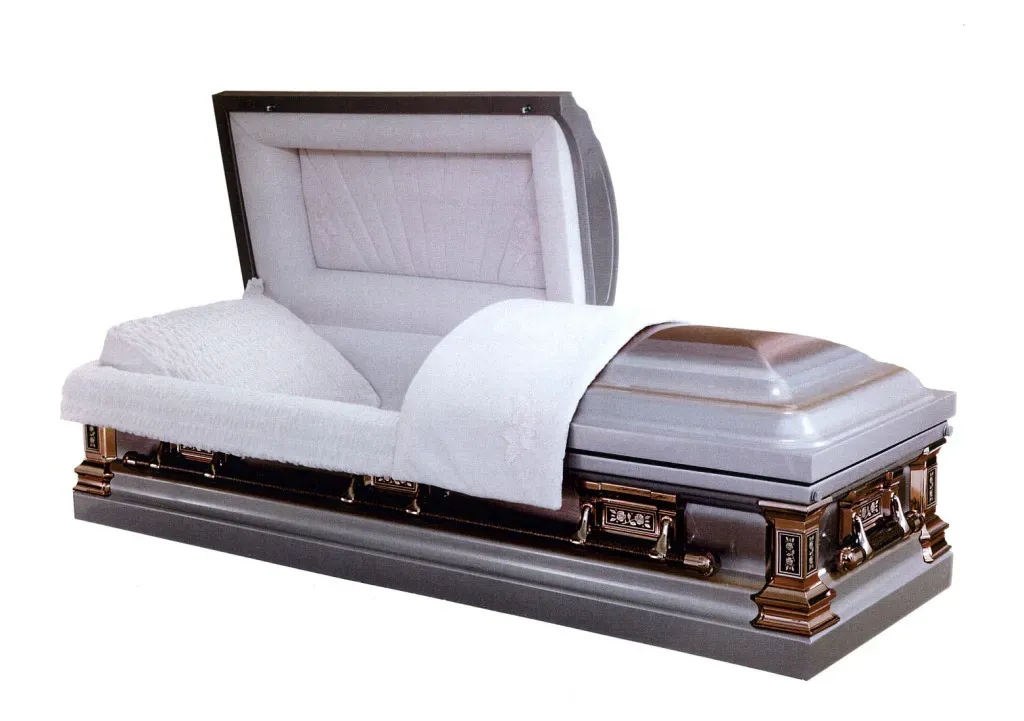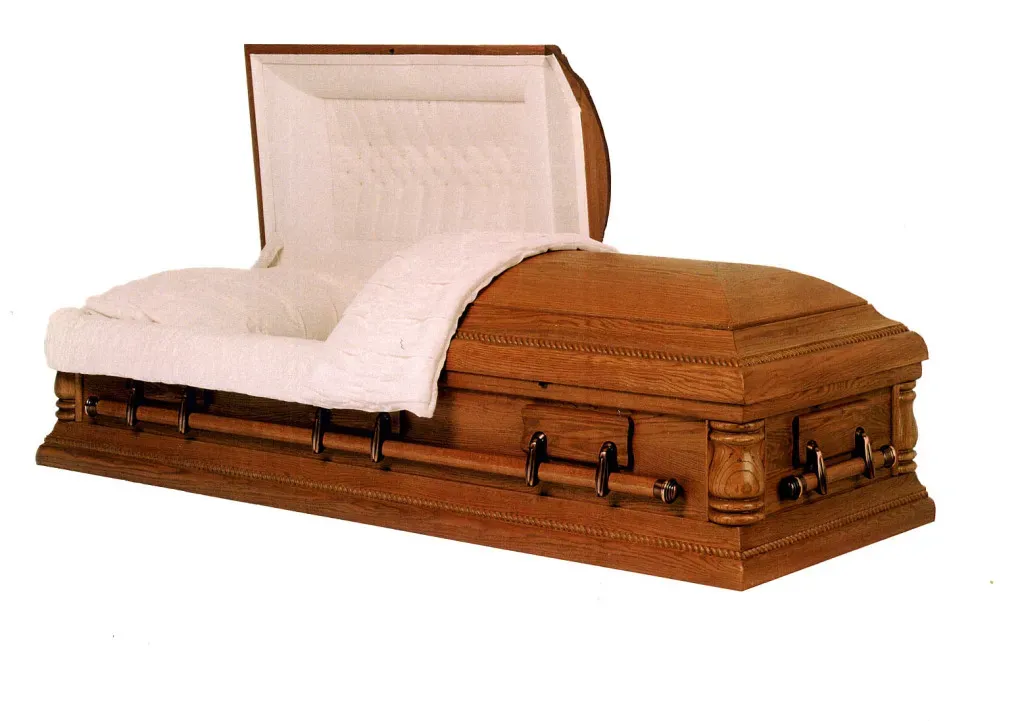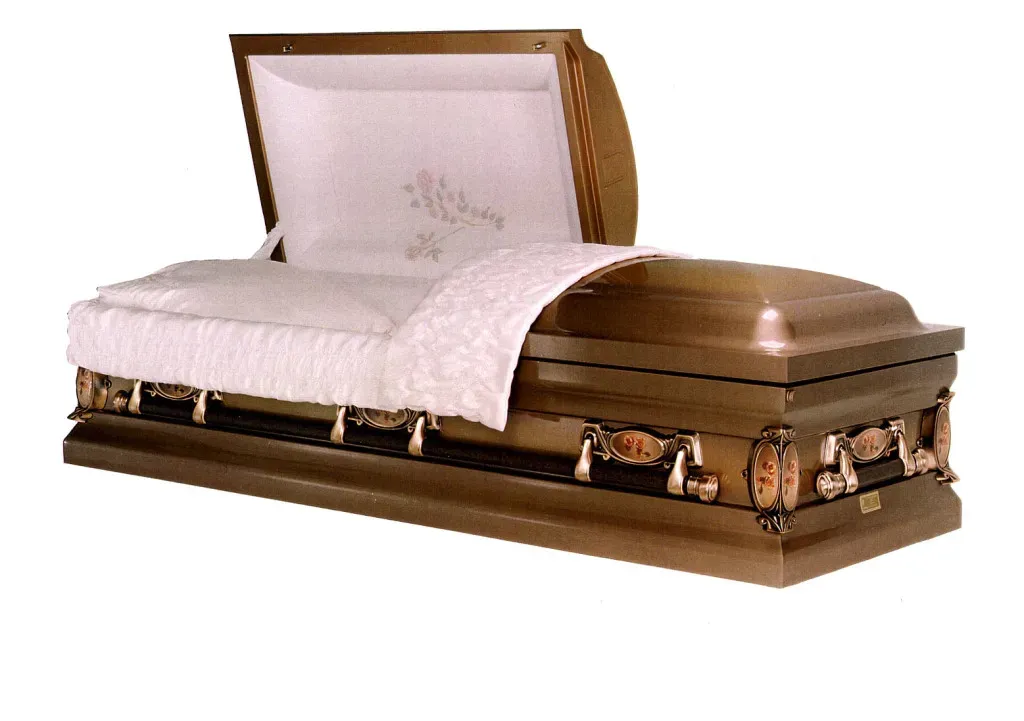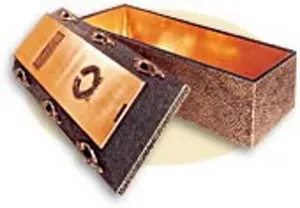Services
Caskets/Vaults
Caskets
Caskets and cremation containers come in a wide variety of materials, designs and costs. The type of casket or ceremonial cremation container selected will determine its value and cost. Generally, casket prices range from least to most expensive according in these types:
Cloth Covered Caskets are made from corrugated fiberboard, pressed wood or softwoods, which are then covered with cloth and have finished interiors.
Steel Gauges Used for Caskets: Steel commonly used in the production of caskets is 20-gauge, 18-gauge or 16-gauge. 20-gauge is the lightest steel commonly used in casket production while 16-gauge steel is the heaviest.
Non-gasketed Steel Caskets are normally made of 20-gauge steel (some companies are experimenting with 22-gauge steel). Twenty-gauge steel is the same thickness used in many automobile body panels. These caskets may be spot-welded. They are usually the least expensive metal caskets available and are usually square-cornered designs. Some nongasketed steel caskets include interior coatings.
Most Hardwood Caskets are made of solid wood, finished in a satin or gloss coat. Some may be hand polished. Their design may be square-cornered, round-cornered or round-cornered urn shapes. Typically, select woods (poplar, willow) will be the least expensive wood caskets, followed by pine, oak, birch, maple, cherry, black walnut and mahogany. Other species of wood used in the manufacture of caskets are ash, elm, redwood, cedar, etc. It takes 130 to 150 board feet of lumber to produce a typical hardwood casket. Some caskets require more wood if they are made of 3" or 4" plank material. Hardwood caskets are sometimes the most expensive caskets manufactured. Solid hardwood caskets are manufactured like fine furniture. They are assembled by craftsmen; sanded for painting or staining. Some have hand-rubbed finishes.
Most recently, Batesville Casket Company has introduced an engineered wood product that the company has trademarked as Marquetry.
Veneer-finished caskets are generally less expensive than solid wood caskets. Stainless Steel Caskets are most often square-cornered or square cornered urn designs. New products designs developed in the 1990s include round-cornered and roundcornered urn stainless steel casket designs. Stainless steel caskets often are comparable in price to midrange hardwood caskets and bridge the price brackets between cold-rolled steel caskets and semiprecious metal products such as copper or bronze. Stainless steel caskets have become increasingly popular in the 1990's and continue to outsell copper or bronze caskets into the 2000's.
Copper or Bronze Caskets may be found in square-cornered, round-cornered or urn shaped designs. Rather than gauge, copper and bronze caskets are measured by weight. A 32-oz. copper or bronze casket means that the copper or bronze used weighed 32-oz. per square foot. There are also 48-oz. copper or bronze caskets.
The Casket & Funeral Supply Association of America estimates that of the 1.7 million caskets sold in 2007 production by type was about:
- 10.8% Cloth covered caskets (including products used in cremation)
- 15.6% Non-gasketed steel
- 17.8% Hardwood
- 47.3% Gasketed Steel
- 4.0% Stainless Steel
- 2.2% Copper or bronze 1.9% Infant & Children (14 and under)
- Less than 1% of all caskets are made from composite materials.
WARRANTY DISCLAIMER: Ronan Funeral Home makes no representations or warranties regarding caskets, outer burial containers or other funeral goods sold by the funeral home. The only warranties, express or implied, granted in connection with the goods sold are the express written warranties, if any, extended by the manufacturers thereof. No other warranties, express or implied, including the express written warranties of merchantability or fitness for a particular purpose, are extended by the Ronan Funeral Home
Augusta Semiprecious metal, Bronze finish with full tufted beige velvet interior. Gasketed Casket.
Kingston Premium hardwood, Walnut with natural walnut satin finish and full tufted dawn velvet interior. Non-gasketed Casket.
Manchester semiprecious metal Copper. Beacon brushed, with full tufted champagne velvet interior. Gasketed Casket.
Manchester Semiprecious metal, Copper. Rose brushed exterior, with mist pink velvet interior. Gasketed Casket.
Franklin Premium hardwood, Mahagony, traditional luster finish with large tufted beige velvet interior. Non-gasketed casket.
Stainless II. Premium stainless steel, natural brushed finish, large and small pipes OR American Flag, blue velvet. Gasketed casket.
Heritage Premium hardwood, Cherry, heritage satin finish, pipe and plain rosetan velvet. Non-gasketed casket.
Bristol Premium hardwood Cherry, colonial luster finish with arched, tufted pipe rosetan velvet. Non-gasketed.
Rose Premium stainless, Rose brushed finish, mist pink velvet interior. Gasketed casket.
Innisbrook Heavy weight steel. Bronze blended brush finish, sunburst beige velvet interior. Gasketed casket.
Silver Premium stainless, silver brushed finish, ivory velvet interior. Gasketed casket.
Praying Hands Premium stainless, Atlantic blue brushed finish, blue velvet interior, praying hands panel. Gasketed casket.
Jamison Solid hardwood, maple, natural luster finish, with arbor rose pink velvet OR large to small piping in camellia velvet. Non-gasketed casket.
Harrington Solid hardwood, oak, tawny oak satin finish, offset tufted pipe in moselle velvet. Non-gasketed.
Benton Solid hardwood, maple, amber satin finish, sand velvet interior, large or small pipe OR American Flag. Non-gasketed casket.
Braddock. Medium weight steel, bronze brushed copper finish, inverted arch in rosetan velvet. Gasketed casket.
Kensington Medium weight steel in blue brushed gold with offset tufted blue velvet. Gasketed casket.
Rose Medium weight steel in orchid brushed, mist pink velvet. Gasketed casket.
Hampton Solid hardwood, oak in two tone luster finish, arched pipe panel in rosetan crepe. Non-gasketed.
Hampton Solid hardwood,Patriotic, oak in two tone luster finish with premium blue velvet and choice of service emblem or American Flag. Non-gasketed.
Cranwell Medium weight steel in silver mist finish with ivory crepe OR sienna bronze finish with rosetan crepe, sunburst. Gasketed casket.
Preston Solid hardwood, poplar pecan gloss finish, with pipes in rosetan velvet. Non-gasketed.
Darlington Solid hardwood, oak nut brown finish, tailored pipe in eggshell crepe. Non-gasketed.
Holbrook Solid hardwood, poplar auburn red gloss, arched pipes in rosetan crepe. Non-gasketed.
Homecoming Medium weight steel in metallic blue shaded silver, blue crepe with "Going Home" panel OR Bronze shaded gold, rosetan crepe with "Going Home" panel OR white shaded orchid in pink crepe with "Going Home" panel Gasketed casket.
Penn Solid hardwood, poplar pecan gloss finish, tailored rosetan crepe. Non-gasketed.
Marion Medium weight steel in burnished gold or purity white with pink shading, wandering rose panel in pink crepe. Gasketed casket.
Weston Solid hardwood, poplar auburn red gloss finish with rosetan crepe. Non-gasketed casket.
Patriot Medium weight steel in metallic blue shaded silver in blue crepe with American Flag. Gasketed casket.
Lord's Prayer Medium weight steel in Hawthorne bronze shaded gold with rosetan crepe and Bible panel. OR metallic blue shaded silver with blue crepe and Bible panel. Gasketed casket.
Praying Hands Medium weight steel in white with oyster crepe and Praying Hands panel OR Hawthorne bronze shaded gold with rosetan crepe and Praying Hands panel OR metallic blue shaded silver with blue crepe and Parying Hands panel OR white shaded pink with light pink crepe and Praying Hands panel. Gasketed casket.
Richmond Light weight steel in golden fawn finish with rosetan crepe and sunburst panel OR copper finish with rosetan crepe OR blue with blue crepe OR silver rose with pink crepe OR silver finish with ivory crepe. Gasketed casket.
Everett Solid hardwood, poplar satin finish and eggshell crepe interior. Non-gasketed casket.
New Horizon Medium weight steel in gray shaded with silver with oyster crepe OR all white finish with ivory crepe OR bronze finish shaded with gold in rosetan crepe OR powder blue finish with blue crepe OR dark blue finish with blue crepe OR white shaded pink with pink crepe. Gasketed casket.
Mother's Rose Light weight steel in light orchid with pink crepe and vine rose with "Mother". Gasketed casket.
Kinsey Fiberboard cardboard with gray embossed cloth covering and ivory twill interior. Non-gasketed.
Treemont Light weight steel in blue shaded silver with blue crepe OR white shaded orchid with pink crepe OR silver shaded ebony with oyster crepe OR copper shaded ebony with rosetan crepe. Gasketed casket.
Cremation Selections
These caskets are also suitable for burial
Carter Solid hardwood, poplar medium honey satin finish with rosetan crepe.
Raleigh Cherry veneer over medium density fiberboard, rosetan crepe.
Wharton Solid hardwood, poplar auburn red satin finish with rosetan crepe.
Rosemont Cherry finish veneer over medium density fiberboard, rosetan crepe.
Glenwood Oak finish veneer over medium density fiberboard, rosetan crepe.
Salem. Cardboard with Crimson cloth exterior and ivory crepe OR Blue cloth exterior and ivory crepe.
Kinsey Fiberboard or cardboard with gray embossed cloth covering and ivory twill interior
Standard Carboard with gray flannel exterior covering and ivory crepe.
Ceremonial Container Solid hardwood shell with rosetan crepe interior. A new interior cremation container is inserted for each use.
Outer Burial Containers
Making funeral arrangements can be emotionally and physically exhausting. Choosing the necessities, although overwhelming, is easier if you know what you want and how much you can afford to spend. Learn how to select an outer burial container that meets your needs and fits your budget.
- Understand that an outer burial container is the outer container that protects the casket. Caskets settle in the ground over time, and heavy equipment from above can shift the ground. The outer burial container is made to withstand the forces that act on the casket to avoid ground shifting and damage to the casket.
- Realize that there are two kinds of outer burial containers that vary in price, functionality and the material from which they are made. A grave box is the most basic outer container. Made from concrete, grave boxes are unlined and have holes in the bottom to allow water to flow through freely. The grave box is the most cost effective. The top-of-the-line outer burial container is a lined burial vault. Offering the greatest protection to the casket and surrounding ground, the lined burial vault is the most expensive.
- Know where to shop for an outer burial container. You can select an outer burial container through the funeral home that is performing the service for your loved one.
WARRANTY DISCLAIMER: Ronan Funeral Home makes no representations or warranties regarding caskets, outer burial containers or other funeral goods sold by the funeral home. The only warranties, express or implied, granted in connection with the goods sold are the express written warranties, if any, extended by the manufacturers thereof. No other warranties, express or implied, including the express written warranties of merchantability or fitness for a particular purpose, are extended by the Ronan Funeral Home
The Bronze: 16 oz Bronze sheet finishing liner bonded to the polystyrene inner liner and interior base and cover with matching exterior Bronze cover shield. Bronze-plated extension bars and matching name/date and emblem provide final elegant touches. Butyl rubber compound bonds the base and cover into a single unit.
The Pantheon: a gleaming polished copper liner is bonded to concrete and polystyrene structure for ultimate beauty. Six antique-plated casket syle handles adorn the lid. Name/date plaque and religious or fraternal emblem adorn the lid for a crowning touch. Butyl rubber compound bonds the base and cover into a single unit.
Regency: a concrete and polystyrene structure is enhanced by a gleaming mirror-finish 26 gauge stainless steel lining Featuring chrome plated casket style hardware and Name/Date plaque with religious or fraternal emblem. Butyl rubber compound bonds the base and cover into a single unit.
Corinthian: solid concrete structure wrapped in Martite polystyrene for a truly elegant appearance. Available in gray, black, white, cherry or oak finish with Name/Date plaque and religious or fraternal emblem A truly uniqe and fitting choice. Butyl rubber compound bonds the base and cover into a single unit.
Vanguard: A deluxe enclosure offering a combination of rugged strength along with a refined classic look. Six handsome casket style handles adorn the cover which is further enhanced with a Name/Date plaque and religious or fraternal insignia. Butyl rubber compound bonds the base and cover into a single unit.
Guardian: combining the toughness of steel with the massive strength of concrete..at an affordable price in a clean, modern style. Strong enough to maintain the integrity of the grave, it is an ideal choice for those to whom quality is a foremost consideration. A tongue and groove sealing mechanism bonds the cover and base to form a single, integral unit.
Sentinel: A moisture resistant inner liner of polystyrene bonded to over a ton of reinforced concrete. Available in several colors in high gloss textured finish with Name/Date plaque and religious or fraternal emblem. Butyl rubber compound bonds the base and cover into a single unit.
Seville: combines the classic look of fine white marble in a polstyrene liner bonded to over a ton of reinforced concrete. Matching cover shield and gold tone extension bar handles with Name/Date plaque complete this unit. Butyl rubber compound bonds the base and cover into a single unit.
Concrete Roughbox or Graveliner: Scientifcally engineered to provide basic grave integrity at a minimum cost. Stronger and more durable than required to sustain earth weight and stress, they feature reinforced precast concrete construction and arched cover for maximum strength and rigidity. No sealing mechanism and drain hole(s) in bottom.
A Year of Grief Support
Sign up for one year of weekly grief messages designed to provide strength and comfort during this challenging time.
Please wait
Verifying your email address
Please wait
Unsubscribing your email address
You have been unsubscribed
You will no longer receive messages from our email mailing list.
You have been subscribed
Your email address has successfully been added to our mailing list.
Something went wrong
There was an error verifying your email address. Please try again later, or re-subscribe.
© Ronan Funeral Home . All Rights Reserved.
© Ronan Funeral Home . All Rights Reserved.























































